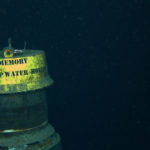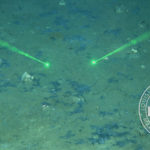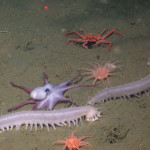
Image courtesy Dr. Erik Cordes, Expedition to the Deep Slope, NOAA/MMS
The deep-sea gorgonian genus Iridogorgia sp. is characterized by a partially calcareous axis with an open, upright spiral or helix arrangement (Verrill, 1883) used to strain food from the water column. Three new species were described last year (Watling 2007). According to Dr. Steve Cairns at Smithsonian NMNH, this is Iridogorgia pourtalesii Verrill, 1883. It’s the type species for the genus. Picture from 1410 m depth in Green Canyon 854 on the 2007 Expedition to the Deep Slope in the Gulf of Mexico.
AE Verrill (1883) described the family Chrysogorgidae to which Iridogorgia belongs, calling them “the most beautiful and interesting of all the known gorgonians”. He compares the iridescent colors of the axis to burnished gold, mother-of-pearl, and the “most brilliant tropical beetles”. Shrimp like these colonies, too. How many do you count living in the branches?
References:
Verill, AE. 1883. Report on the Anthozoa, and on some additional species dredged by the “Blake” in 1877-1879, and by the U.S. Fish Commission steamer “Fish Hawk” in 1880-82. Bull. Mus. Comp. Zool. Harvard 11:1-72, pls. 1-8.
Watling, L. 2007. A review of the genus Iridogorgia (Octocorallia: Chrysogorgiidae) and its relatives, chiefly from the North Atlantic Ocean. Journal of the Marine Biological Association of the UK. 87: 393-402. doi:10.1017/S002531540705535X






“the most beautiful and interesting of all the known gorgonians”
This somehow summed up my thoughts when I saw the picture. Good find!